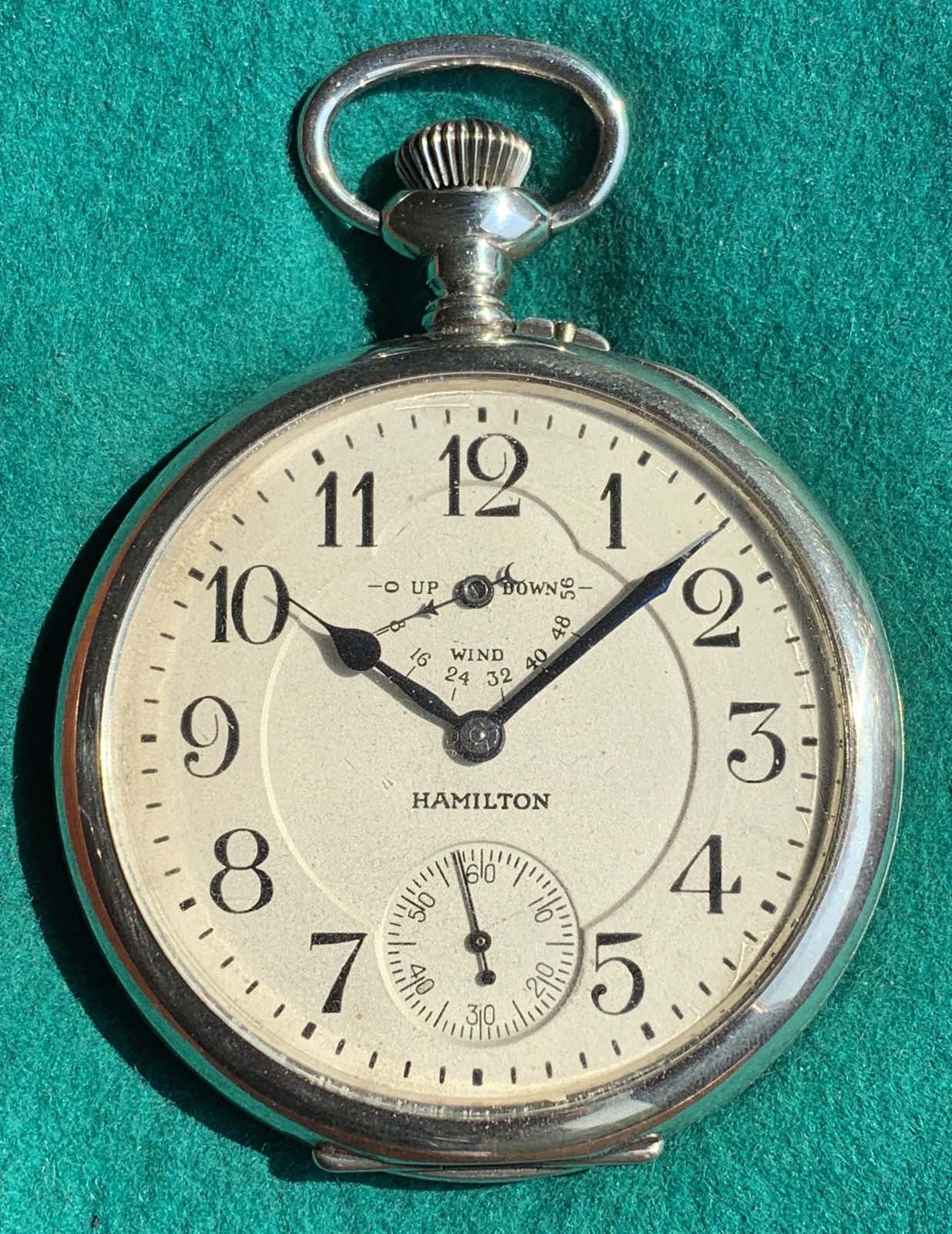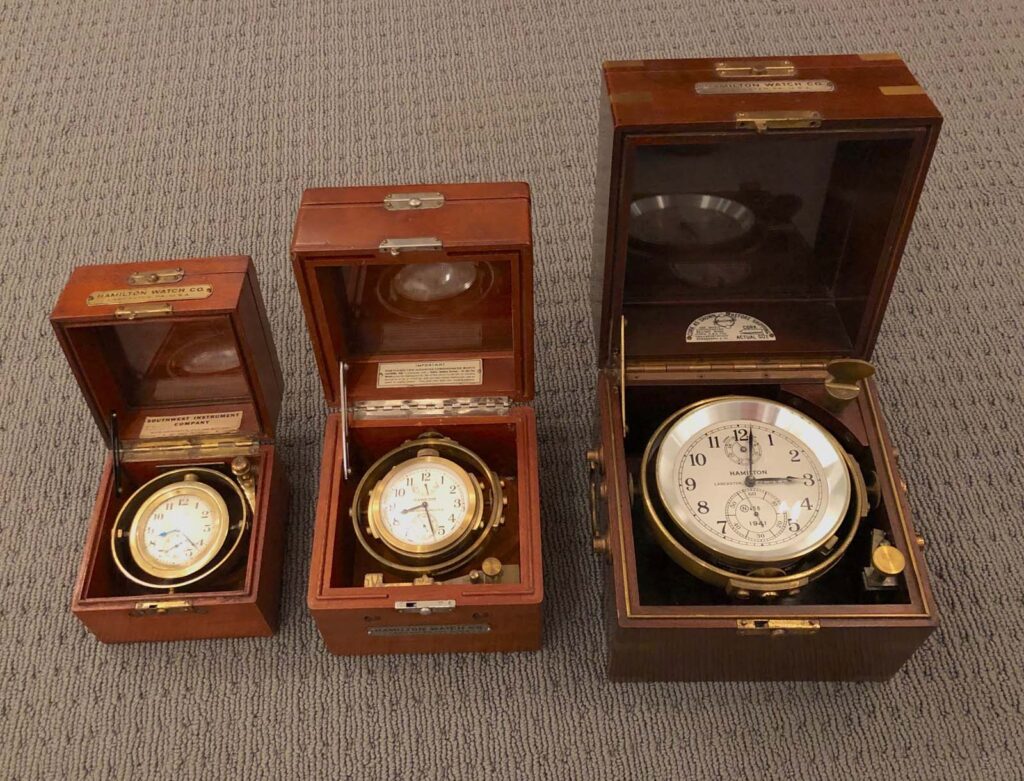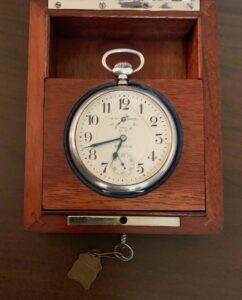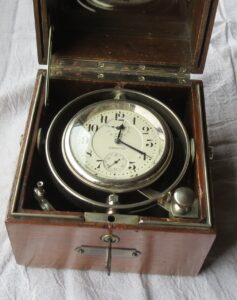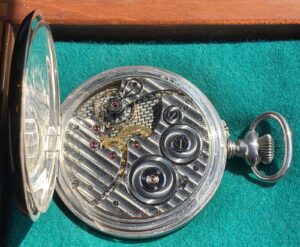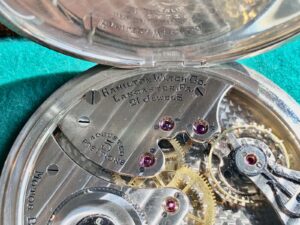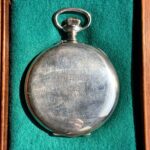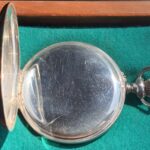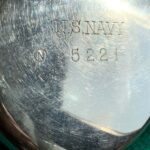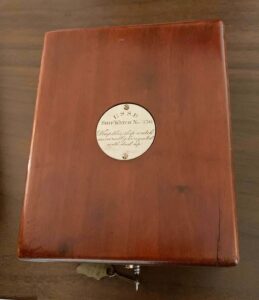Hamilton watch company was founded in 1892 with the consolidation of several watch companies, including Aurora Watch Co, Lancaster Watch Co, and Keystone Watch Co. Their initial products were pocket watches for personal use.
The Longitude Problem
Navigation, especially at sea, has relied upon accurate timekeeping to solve the Longitude Problem. Latitude – your north/south position – can be determined by celestial navigation – referencing the sun or stars. Longitude – your east/west position, can’t be determined by celestial bodies because the earth rotates.
The solution to the Longitude problem was hypothesized by Greek mathematicians more than 2000 years ago. They understood that if you could know accurately what time it was at some reference location and compare that to local time (it’s easy to figure out when local noon is by watching for the sun’s highest point), you could translate that to an east/west position.
The practical solution to the Longitude Problem did not appear until the mid-1700s, with the work funded by the imperialists and solved by a clockmaker named John Harrison. The main advances of the naval chronometer were a bimetallic compensated balance and a detent escapement. Harrison achieved the rate stability of within just a fraction of a second of gain or loss per day.
High accuracy is important on long voyages because errors compound. Careful navigational work plus an accurate chronometer will reckon your position to within less than a mile on a 90-day voyage.
One of the most recognizable features of a naval chronometer is the gimbal mount for the movement. This ensures the chronometer always runs in the same dial up position. It’s much easier to regulate a watch for good time keeping in one orientation than to have to push and pull and balance things so the watch runs at the same speed in different orientations, since every change in position means the pivots and other components fit slightly differently.
Full-blown naval chronometers with detent escapements were standard equipment on ocean-going ships from their invention in the late 18th Century through World War II. They were incredibly expensive and time consuming to make; the combined output of English and Swiss manufacturers was only about 300 units per year. The cost was justified for ships that routinely crossed oceans, but was an unnecessary expense for vessels that made shorter trips.
Hamilton eventually made a full chronometer – the Model 21, designed in 1941 and used extensively in World War II. Before this, they made navigational pieces that were adaptations of conventional watches that were more cost-effective than detent escapement chronometers, but still adequate for shorter voyages.
One of Hamilton’s earliest attempts at a navigational watch was a gimble-mounted model 940. The 940 pocket watch was a high-quality 18-size movement used in railroad service. A few of them were gimbal mounted for navigational usage.
This picture shows a Hamilton 940 watch mounted in a gimbaled box dating to around 1917 at the left, a Hamilton model 22 Chronometer Watch in the center and a Hamilton model 21 Chronometer at right. Both the model 21 and 22 date to the early 1940’s.
During World War I, the US Navy commissioned Hamilton to make a more purpose-built movement for navigational use. The result was the Hamilton 36-size Chronometer Watch. This is sometimes called a Torpedo Boat Watch.
The Torpedo Boat
Torpedo boats were first conceived around the American Civil War. They were originally sail-powered and later became steam-powered. They were small and fast, and were designed to be able to out-maneuver larger battle ships. A typical voyage would be hours or a few days, so extreme timekeeping accuracy was not as important, as even a moderately large error in the chronometer rate would lead to only a small positional error over a short voyage.
Torpedo boat watches were made by other companies including Swiss manufacturer Zenith. Many Hamilton navigational timepieces were styled after European pieces, including the Hamilton 36-Size.
Hamilton 36-Size Chronometer
The Hamilton 36-size Chronometer watch is a large movement by pocket watch standards – about 2 1/2″ in diameter. It was made in two versions – an open-face watch style with a pin-set movement, stem wind, and a wind indicator, and a gimbaled version with a sliding rear plate that revealed the winding key hole. On the gimbaled version, setting the time was achieved by using the small end of the winding key on the nut attached to the minute hand.
The watch runs for about 56 hours on a wind. The movement has 21 jewels, a motor barrel, and a double roller. The U.S. Naval Observatory paid Hamilton approximately $67.00 for each watch, which in today’s dollars is about $2000.
The Hamilton 36-size is called a Chronometer Watch but is not a full chronometer as it has a conventional lever escapement, rather than a detent escapement found in full chronometers. The 56 hour runtime of the 36-Size was not really intended to be used; the watch was designed to be wound every day like a conventional watch; but the long runtime offered two advantages: First that if by some dereliction of duty of the signalman forgot to wind the watch, there was enough margin for the watch to still be running by winding time of the next day. More importantly, the extra runtime meant that only the first half of the spring’s power was used, which reduced the variation in spring strength between being fully wound and half-wound, rather than using the entire power curve of a shorter spring. This translates to better timekeeping.
Hamilton made very few of these – only 970, with about 500 made in gimbal-mount form and 500 made in a sterling silver open-face form. They were produced starting in 1916 and the last watch of the series was finished in 1945. The open-face watches start at serial number 1260001, and the gimbal-mounted watches at around 1260501. It appears that Hamilton made both the open face and gimbal versions concurrently, though I believe the first 200 made were open-face style.
These time pieces were available exclusively to the US Military until about 1923, when Hamilton found themselves with excess inventory and a cooling interest from the government. The watches were then made available to jewelers.
My Hamilton 36-size is the open-face version. The case is engraved US Navy and was made by Crescent Watch Case company and is in the vicinity of 10 ounces. The case has a plain cuvette.
The watches were delivered in locking wooden boxes with a silver plaque engrave with “USSB Sip Watch No” followed by the watch serial number, and “Keep this ship watch invariably horizontal with dial up.” The interior of the box has a wooden receptacle for the watch that allows winding the watch without removing it.
Unfortunately my 36-size does not have the original case – the case I have is from a Hamilton open-face model 22, but a friend has an original box pictured here.
These watches are fine timekeepers, and reflected 25 years of Hamilton watchmaking experience, not counting the decades of experience of Hamilton’s preceding companies. The watch had a flaw, however – the up/down wind indicator is a complicated design with a friction coupling to the spring barrel. Because of this, it is extremely sensitive and even when new, would frequently become misaligned and not accurately show the amount of runtime remaining.
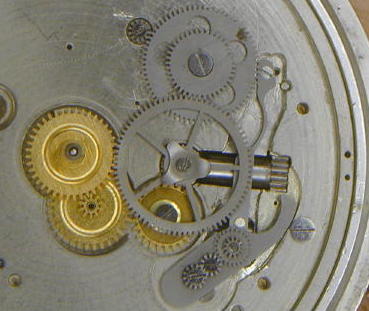 The US Naval Observatory and Hamilton worked to address this, but never really succeeded. In fact, some of the surviving gimbal-mounted watches were modified by the USNO to remove the wind indicator and plug the hole in the dial; the Navy being content to use them as timekeepers and hoping the crew would remember to wind them.
The US Naval Observatory and Hamilton worked to address this, but never really succeeded. In fact, some of the surviving gimbal-mounted watches were modified by the USNO to remove the wind indicator and plug the hole in the dial; the Navy being content to use them as timekeepers and hoping the crew would remember to wind them.
The 36-size Chronometer Watch was not a particular commercial success – Hamilton had unsold pieces on their books for years, but in many ways the 36-Size laid the groundwork for the later model 22 Chronometer Watch, which Hamilton sold a huge number of. The model 22, mercifully, has a redesigned and properly functioning wind indicator mechanism.
Additional information
Very little is documented on these pieces, and there are a number of discrepancies between sources. This thread from the NAWCC message board contains most of the information I have been able to find and includes pictures of the wind indicator gear setup.
The following are a pair of forum posts by Fred R. Hougham that are valuable. The posts are reproduced here in case the original site becomes unavailable.
Forum Post 1 by Fred R. Hougham
From My Fathers Military Records:
HAMILTON 36 SIZE WATCH
Fred C. Hougham and Bill Schroeder
The origin and history of the Hamilton 36 size movement is somewhat of an enigma. Only 970 were made. Although some is known about this great watch, much is not. For example, this is the only known Hamilton watch without a factory number designation. It is just the “36 size “. In addition, there is no known material list or service instructions for the watch, much less the up-down mechanism. The watch runs for 70-72 hours when folly wound and yet the up-down mechanism only registers 56 hours. The winding indicator hand continues to function past the 56 hour mark until the watch runs down. Measurements of a representative group of parts show that the factory did not use parts from another Hamilton in this watch. This was a new watch from the “plates up”. Serial numbers ran consecutively from 1,260,001 to 1,260,970. The watches were finished over a period of years from 1918 until about 1945.
The movement is described as follows:
Pin setting, pendant winding watches or key wind-key set. Twenty-One ruby and sapphire Gold jewel settings. Double roller escapement. Steel escape wheel. Exposed sapphire pallet stones. Pallet arbor cone pivoted and cap. jeweled. Escape pinion cone pivoted and cap jeweled. Compensating balance, pivots running on rubies. Breguet hairspring. Micro metric or plain regulator. Adjusted to temperature, isochronism, five positions. Safety barrel with spring box rigidly mounted on bridge. Exposed winding wheels. Patent recoiling click and self locking setting device. Silvered double sunk dial with painted figures and numerals. Plates beautifully damascened and finely finished.
It is not known if the Navy or War Shipping Board provided the specifications for this particular watch although it is known that about 1900 the Navy revised the specifications for deck watches/torpedo boat watches in general and allowed a 15 second per month time variance. At the same time they changed the nomenclature for pocket chronometers/deck watches to torpedo boat watches. Detailed specifications for these may be found in Marvin Whitney’s book Military Timepieces on page 382. The “36 size” watch was made in two styles, a Ship’s Watch which was key wind/key set swung on gimbals mounted in a mahogany box and a Patrol Boat Watch which was stem wind/pin set in a plain open face sterling silver 36 size ease.
The first 200 of these were Ship’s Watches ‘and were to be billed to the United States War Shipping Board, Emergency Fleet Corporation, Washington, D.C. The requisition for 200 watches was given to Hamilton July 10,1917 by the War Shipping Board. The watches were delivered by messenger to the Bureau of Standards in Washington for testing. They were tested there and payment was approved as follows: June 29,1918 – 66 watches; August 12,1918 – 68 watches; February 26, 1919 – 66 watches; for the total of 200 watches. The watches were billed at $67.00 each and on February 26,1919 at which time billing was completed, an additional bill for $1,429.85 was rendered covering a premium which was allowed for “extra performance” as per the requisition contract. “60” was the mean standard for performance and 157 watches averaged 7 points higher than “60”and thus were rated premium. 47 watches averaged 3 points less than “60”. It is not known what criteria was used to score the watches performance. The ship’s watch description on the billing invoice read as follows:
“36s – 21 J High grade watches complete and in accordance with the fall specifications for Ship’s Watches of June 19,1917 – – – – -$67.00 Net.
On August 29, 1923 a letter was received by Hamilton asking them to place a return value on a number of watches that were being held as surplus by the Shipping Board Emergency Fleet Corporation. Hamilton replied that “because orders had been canceled by the government, a number of these watches are in our stock and we do not feel that we can add to that stock.”
Patrol Boat Watches were to be billed to the Naval Observatory, Washington, D.C. as follows:
36 s Patrol Boat Watches fitted in Silver cases.
There were two orders –
Schedule – Requisition 158/18 – Charged at $56.50
Requisition 123 – Bureau N.S.A. – Charged at $56.00
These watches were delivered by messenger to the Bureau of Standards to be tested there. Those that did not pass the tests were returned to the factory for further adjustments. Bills were rendered as the watches were accepted. The bills listed below cover the larger items of sales traced from the factory sales records. The total – 259 – were traced as follows:
1918 Oct. 2, 80-Requisition #123
Nov. 23, 9- ” #123
Nov. 23, 39-‘ ” #158/18
1920 July 15, 47- ” #158/18
Oct. 9, 46- ” #158/18
1921 Aug. 3, 38 ” #158/18
After the war ended, a part of one government order was canceled but details are not available.
Forum post 2 by Fred R. Hougham:
Tom,
Please find enclosed a copy of a letter written in 1994 by the late Marvin Whitney to a Mr. Warren Niebling. This should answer some of your questions. If I can ever find the time to finish the second part of the info on the 36 size it contains some pictures of the under dial gearing, relating to the set up for the winding indicator.
Regards
Fred
P.S. Forgive the errors, sometimes the scan picks up things that aren’t there.
AMERICAN WATCHMAKERS INSTITUTE
3700 Harrison Avenue Cincinnati. Ohio 46211 (513)661-3838
Mailing address: P.O. Box 11011. Cincinnati. Ohio 45211
Warren H. Niebling
303 Suffolk. Rd
Flourtown Pa. 19031-5119
Dear Mr. Niebling;
I appreciate your kind remarks regarding the H. T, articles.
The two watches described were “built, specifically for the Navy during W. W. I and were known as their 36 size torpedo boat watches. Production was started in 1916 with a production run of 966 instruments, ‘being assigned movement numbers falling between l,260,001 and 1,260,970.
Specifications stated that the torpedo boat watch shall be made to run for not less than 56 hours, and on the dial an up-and-down indicator shall be provided to show the state of winding. The watch shall be stem wound and pin set, and fitted in an open face silver case. The majority of these watches were fitted to this style case. However, some were- fitted to a weighted chrome bowl, swung in gimbals and mounted in a 3-tier chronometer style box. The silver cases were made by the Crescent Watch Casa Co,Newark. N. J.
Both the non-gimbal and gimbaled type were fitted with a winding indicator as noted in the specifications when they were delivered to the Naval Observatory. I have never seen one that was housed in a silver case with-out a winding indicator. However, with the mounted its been a different story. At one time I had three gimbaled pieces in my collection. One had the complete winding indicator mechanism, while the other two some parts were missing from the W. I. mechanism and the holes-were plugged. On one, the winding indicator numerals remained on the dial; on the other, the dial had been refinished and the only way you could tell it was plugged was to look at the underside.
Daring my tenure at the Naval observatory in the early 40’s, a few of these watches were still in service and from time to time were returned for an overhaul, However, we only had a limited number of replacement parts and most of those were parts that seldom needed to be replaced, The winding mechanism was completed and consisted of eight thin steel wheels, two sets of friction springs, and a pivoted spring loaded arm which engaged and dis-engaged the mechanism. On those that came in for an overhaul that had missing/broken parts, the dial was plugged and refinished. You mentioned that the plug in your piece was rounded slightly. That job was not done at the Observatory for all of ours were finished flush with the dial.
I know of no material list or parts numbers for this Jo’s T.B.W. movement.
The Observatory’s parts department did not have any-such information,
If I may be of any further help, please, feel free to contact me.
Sincerely yours
Marvin E. Whitney
Note: Two photos above were reproduced from the NAWCC thread linked above. I am in the process of getting permission to use these photos, but in the interest of horological education, I am posting these presuming that copyright permission will be granted.
